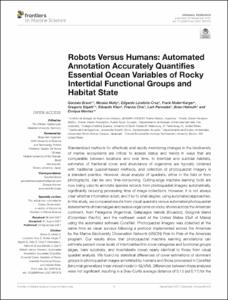| dc.contributor.author | Bravo, Gonzalo | |
| dc.contributor.author | Moity, Nicolas | |
| dc.contributor.author | Londoño-Cruz, Edgardo | |
| dc.contributor.author | Muller-Karger, Frank | |
| dc.contributor.author | Bigatti, Gregorio | |
| dc.contributor.author | Klein, Eduardo | |
| dc.contributor.author | Choi, Francis | |
| dc.contributor.author | Parmalee, Lark | |
| dc.contributor.author | Helmuth, Brian | |
| dc.contributor.author | Montes, Enrique | |
| dc.coverage.spatial | Americas | en_US |
| dc.date.accessioned | 2021-09-28T20:43:55Z | |
| dc.date.available | 2021-09-28T20:43:55Z | |
| dc.date.issued | 2021 | |
| dc.identifier.citation | Bravo, G., Moity, N.,
Londoño-Cruz, E., Muller-Karger, F.,
Bigatt,i G., Klein, E., Choi, F., Parmalee, L.,
Helmuth, B. and Montes, E. (2021)
Robots Versus Humans: Automated
Annotation Accurately Quantifies
Essential Ocean Variables of Rocky
Intertidal Functional Groups
and Habitat State.
Frontiers in Marine Science, 8:691313, 12pp.
DOI: 10.3389/fmars.2021.691313 | en_US |
| dc.identifier.uri | https://repository.oceanbestpractices.org/handle/11329/1732 | |
| dc.description.abstract | Standardized methods for effectively and rapidly monitoring changes in the biodiversity
of marine ecosystems are critical to assess status and trends in ways that are
comparable between locations and over time. In intertidal and subtidal habitats,
estimates of fractional cover and abundance of organisms are typically obtained
with traditional quadrat-based methods, and collection of photoquadrat imagery is
a standard practice. However, visual analysis of quadrats, either in the field or from
photographs, can be very time-consuming. Cutting-edge machine learning tools are
now being used to annotate species records from photoquadrat imagery automatically,
significantly reducing processing time of image collections. However, it is not always
clear whether information is lost, and if so to what degree, using automated approaches.
In this study, we compared results from visual quadrats versus automated photoquadrat
assessments of macroalgae and sessile organisms on rocky shores across the American
continent, from Patagonia (Argentina), Galapagos Islands (Ecuador), Gorgona Island
(Colombian Pacific), and the northeast coast of the United States (Gulf of Maine)
using the automated software CoralNet. Photoquadrat imagery was collected at the
same time as visual surveys following a protocol implemented across the Americas
by the Marine Biodiversity Observation Network (MBON) Pole to Pole of the Americas
program. Our results show that photoquadrat machine learning annotations can
estimate percent cover levels of intertidal benthic cover categories and functional groups
(algae, bare substrate, and invertebrate cover) nearly identical to those from visual
quadrat analysis. We found no statistical differences of cover estimations of dominant
groups in photoquadrat images annotated by humans and those processed in CoralNet
(binomial generalized linear mixed model or GLMM). Differences between these analyses
were not significant, resulting in a Bray-Curtis average distance of 0.13 (sd 0.11) for the
full label set, and 0.12 (sd 0.14) for functional groups. This is the first time that CoralNet
automated annotation software has been used to monitor “Invertebrate Abundance
and Distribution” and “Macroalgal Canopy Cover and Composition” Essential Ocean
Variables (EOVs) in intertidal habitats. We recommend its use for rapid, continuous
surveys over expanded geographical scales and monitoring of intertidal areas globally. | en_US |
| dc.language.iso | en | en_US |
| dc.rights | Attribution 4.0 International | * |
| dc.rights.uri | http://creativecommons.org/licenses/by/4.0/ | * |
| dc.subject.other | Biodiversity monitoring | en_US |
| dc.subject.other | Machine learning | en_US |
| dc.subject.other | Essential Ocean Variable (EOV) | en_US |
| dc.subject.other | Photoquadrats | en_US |
| dc.subject.other | Rocky intertidal zone | en_US |
| dc.subject.other | CoralNet | en_US |
| dc.title | Robots Versus Humans: Automated Annotation Accurately Quantifies Essential Ocean Variables of Rocky Intertidal Functional Groups and Habitat State. | en_US |
| dc.type | Journal Contribution | en_US |
| dc.description.refereed | Refereed | en_US |
| dc.format.pagerange | 12pp. | en_US |
| dc.identifier.doi | https://doi.org/10.3389/fmars.2021.691313 | |
| dc.subject.parameterDiscipline | Biota abundance, biomass and diversity | en_US |
| dc.bibliographicCitation.title | Frontiers in Marine Science | en_US |
| dc.bibliographicCitation.volume | 8 | en_US |
| dc.bibliographicCitation.issue | Article 691313 | en_US |
| dc.description.sdg | 14.a | en_US |
| dc.description.eov | Macroalgal canopy cover and composition | en_US |
| dc.description.eov | Invertebrate abundance and distribution | en_US |
| dc.description.methodologyType | Method | en_US |
| dc.description.methodologyType | Reports with methodological relevance | en_US |
| obps.contact.contactname | Gonzalo Bravo | |
| obps.contact.contactemail | gonzalobravoargentina@gmail.com | |
| obps.resourceurl.publisher | https://www.frontiersin.org/articles/10.3389/fmars.2021.691313/ | |
 Repository of community practices in Ocean Research, Applications and Data/Information Management
Repository of community practices in Ocean Research, Applications and Data/Information Management

